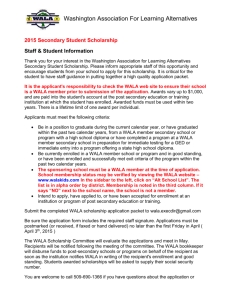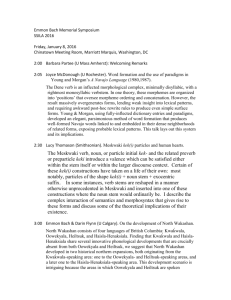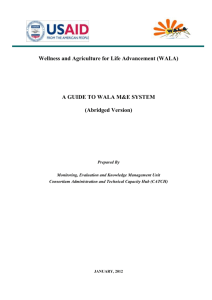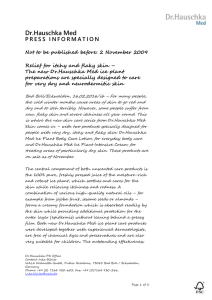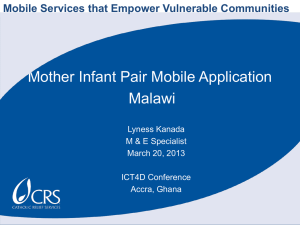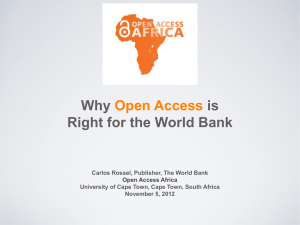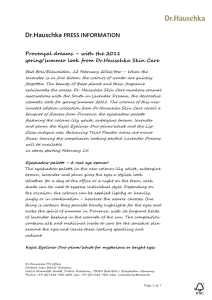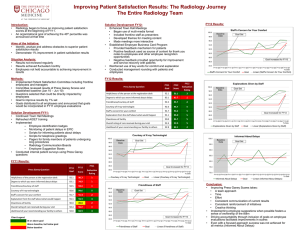Indicator Performance Tracking Table (IPTT) FY09–FY14
advertisement
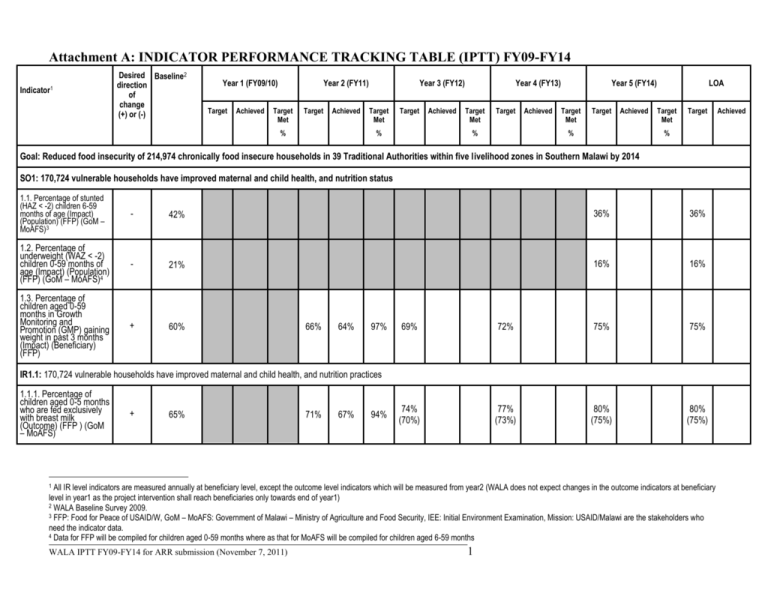
Attachment A: INDICATOR PERFORMANCE TRACKING TABLE (IPTT) FY09-FY14 Indicator1 Desired Baseline2 direction of change (+) or (-) Year 1 (FY09/10) Target Achieved Year 2 (FY11) Target Met Target Achieved % Year 3 (FY12) Target Met Target % Achieved Year 4 (FY13) Target Met Target % Achieved Year 5 (FY14) Target Met Target Achieved % LOA Target Met Target % Goal: Reduced food insecurity of 214,974 chronically food insecure households in 39 Traditional Authorities within five livelihood zones in Southern Malawi by 2014 SO1: 170,724 vulnerable households have improved maternal and child health, and nutrition status 1.1. Percentage of stunted (HAZ < -2) children 6-59 months of age (Impact) (Population) (FFP) (GoM – MoAFS)3 - 42% 36% 36% 1.2. Percentage of underweight (WAZ < -2) children 0-59 months of age (Impact) (Population) (FFP) (GoM – MoAFS)4 - 21% 16% 16% 1.3. Percentage of children aged 0-59 months in Growth Monitoring and Promotion (GMP) gaining weight in past 3 months (Impact) (Beneficiary) (FFP) + 60% 66% 64% 97% 69% 72% 75% 75% 74% (70%) 77% (73%) 80% (75%) 80% (75%) IR1.1: 170,724 vulnerable households have improved maternal and child health, and nutrition practices 1.1.1. Percentage of children aged 0-5 months who are fed exclusively with breast milk (Outcome) (FFP ) (GoM – MoAFS) + 65% 71% 67% 94% All IR level indicators are measured annually at beneficiary level, except the outcome level indicators which will be measured from year2 (WALA does not expect changes in the outcome indicators at beneficiary level in year1 as the project intervention shall reach beneficiaries only towards end of year1) 2 WALA Baseline Survey 2009. 3 FFP: Food for Peace of USAID/W, GoM – MoAFS: Government of Malawi – Ministry of Agriculture and Food Security, IEE: Initial Environment Examination, Mission: USAID/Malawi are the stakeholders who need the indicator data. 4 Data for FFP will be compiled for children aged 0-59 months where as that for MoAFS will be compiled for children aged 6-59 months 1 WALA IPTT FY09-FY14 for ARR submission (November 7, 2011) 1 Achieved Indicator1 Desired Baseline2 direction of change (+) or (-) Year 1 (FY09/10) Target Achieved Year 2 (FY11) Target Met Target Achieved % Year 3 (FY12) Target Met Target % Achieved Year 4 (FY13) Target Met Target % Achieved Year 5 (FY14) Target Met Target % Achieved LOA Target Met Target % 1.1.2. Percentage of children aged 6-23 months who receive a minimum acceptable diet apart from breast milk (continued breast feeding, age appropriate dietary diversity and age appropriate frequency of feeding) (Outcome) (FFP) (GoM – MoAFS) + 12% 24% 22% 92% 30% 36% 42% 42% 1.1.3. Percentage of caregivers of children aged 0-59 months demonstrating proper environmental hygiene behaviours (use of latrines, hand washing and correct use of LLIT bed nets) (Outcome) (FFP) (IEE) (GoM – MoAFS) + 6% 15% 17% 113% 20% 25% 30% 30% 1.1.4. Percentage of households reporting utilization of one or more fuel efficient cooking technologies (such as fuel efficient stoves, solar dryers, fireless cookers, replacing firewood with maize husks, etc) (Outcome) (IEE) + 2% 10% 4% 40% 25% 40% 50% 50% (12%) (20%) (25% (25% 1.1.5. Number (cumulative) of households with at least one member participates in care group (Output) (WALA) + 0 63,000 91,648 145 130,000 138,609 107% 170,724 170,724 170,724 170,724 1.1.6. Number (cumulative) of children reached by USGsupported nutrition programs (Output) (Mission) + 0 65,200 84,204 129 122,890 131,428 107% 174,940 174,940 174,940 174,940 WALA IPTT FY09-FY14 for ARR submission (November 7, 2011) 2 Achieved Indicator1 Desired Baseline2 direction of change (+) or (-) Year 1 (FY09/10) Target Achieved Year 2 (FY11) Target Met Target Achieved % Year 3 (FY12) Target Met Target Achieved % Year 4 (FY13) Target Met Target % Achieved Year 5 (FY14) Target Met Target % Achieved LOA Target Met Target % IR1.2: 170,724 vulnerable households have increased use of quality maternal and child health, and nutrition services 1.2.1. Percentage of children aged 0-59 months regularly attended growth monitoring sessions (Outcome) (WALA) + 41% 50% 51% 102% 60% 70% 80% 80% 1.2.2. Percentage of mothers of children aged 0–11 months who received Vitamin A supplement within 8 weeks of delivery of the child (Outcome) (WALA) + 64% 70% 69% 99% 74% 78% 80% 80% 1.2.3. Percentage of children aged 0–11 months whose births were attended by skilled health personnel (Outcome) (WALA) + 78% 82% 86% 105% 83% (89%) 84% (92%) 85% (95%) 85% (95%) 1.2.4. Number (cumulative) of people trained in child health and nutrition through USG-supported health area programs, disaggregated by gender (Output) (Mission) + 0 6,520 8,234 126 12,289 14,188 115% 17,494 17,494 17,494 17,494 (18,000) (18,000) (18,000) (18,000) Female + 0 3,912 7,747 198 7,373 12,781 173% Male + 0 2,608 487 19 4,916 1,497 30% 10,496 10,496 10,496 10,496 (14,500) (14,500) (14,500) (14,500) 6,998 6,998 6,998 6,998 (3,500) (3,500) (3,500) (3,500) 11.0 11.0 SO2: 147,500 smallholder farming households have improved livelihood status 2.1. Months of adequate household food provisioning (Impact) (Population) (FFP) + 9 WALA IPTT FY09-FY14 for ARR submission (November 7, 2011) 3 Achieved Indicator1 Desired Baseline2 direction of change (+) or (-) Year 1 (FY09/10) Target Achieved Year 2 (FY11) Target Met Target Achieved % 2.2. Average Household Dietary Diversity Score (HDDS) (Impact) (Population) (FFP) (GoM – MoAFS)5 + Year 3 (FY12) Target Met Target % Achieved Year 4 (FY13) Target Met Target Achieved Year 5 (FY14) Target Met % Target % 4 Achieved LOA Target Met Target % 9 9 IR2.1: 147,500 smallholder farming households have improved crop production practices 2.1.1a Percentage of beneficiary households using 3 out of 5 WALA promoted sustainable crop cultivation technologies (outcome) (WALA)6 2.1.1b Percentage of beneficiary households using two of the three WALA promoted soil conservation technologies (outcome) (WALA)7 2.1.1c Percentage of beneficiary households using post harvest handling and post harvest storage technologies (outcome) (WALA) + 27% 35% 30% 86% 45% (40%) 55% (45%) 65% (50%) 65% (50%) + 12% 15% 16% 106% 25% 45% 60% 60% + 34% 40% 41% 103% 45% 50% 55% 55% HDDS for FFP will be compiled for 12 food groups suggested by FANTA whereas HDDS for MoAFS will be compiled for six food groups suggested by the ministry The five sustainable agriculture technologies are - 1) quality seeds, 2) crop rotation, 3) inter-cropping, 4) minimum tillage and 5) mulching 7 Three soil conservation technologies are – 1) Fertilizer trees, 2) contour ridges, box ridges and bunds, and 3) vertiver grass. 5 6 WALA IPTT FY09-FY14 for ARR submission (November 7, 2011) 4 Achieved Indicator1 Desired Baseline2 direction of change (+) or (-) Year 1 (FY09/10) Target Achieved Year 2 (FY11) Target Met Target Achieved % Year 3 (FY12) Target Met Target % Achieved Year 4 (FY13) Target Met Target % Achieved Year 5 (FY14) Target Met Target % Achieved LOA Target Met Target % 2.1.2. Percentage of beneficiaries (individual farmers) using at least 2 of 4 WALA-promoted Integrated Pest Management technologies8 (Outcome) (IEE) (GoM – MoAFS) + 9% 15% 10% 67% 20% 25% 30% 30% 2.1.3. Percentage of irrigation sites installing two or more WALA promoted design considerations9 (Outcome) (WALA) (IEE) + 0 80% 100% 125% 80% 80% 100% 100% 2.1.4. Percentage of water users committees using two or more WALA promoted operational practices10 (Outcome) (WALA) (IEE) + 0 80% 42% 53% 80% 80% 100% 100% 2.1.5. Number (cumulative) of hectares of land brought under irrigation by WALA activities (Outcome) (WALA) (GoM – MoAFS) + 0 200 220 110% 300 400 500 500 2.1.6. Number of new technologies or management practices made available for transfer as a result of USG assistance11 (Output) (Mission) + 0 26 23 88% 26 26 26 26 22 15 60 WALA promoted IPM practices include mechanical, cultural, crop rotation, use of non-chemical/organic pest control products promoted small-scale irrigation design considerations include, but are not limited to: lined canals, drip systems, adequate field drainage structures, vegetative cover, and shutoff valves. 10 Small-scale irrigation WALA promoted operational practices include, but are not limited to: volume-based (or other) use fee, high-frequency, low-flow watering schedule, structure maintenance, clearing of weeds and sediment, periodic drainage of waterlogged fields, periodic flushing out of canals to remove snails. 11 The list of technologies and practices include all those listed under 2.1.1a, 2.1.1b, 2.1.1c, 2.1.2, 2.1.3 and 2.1.4. 8 9WALA WALA IPTT FY09-FY14 for ARR submission (November 7, 2011) 5 Achieved Indicator1 Desired Baseline2 direction of change (+) or (-) Year 1 (FY09/10) Target Achieved Year 2 (FY11) Target Met Target Achieved % Year 3 (FY12) Target Met Target % Achieved Year 4 (FY13) Target Met Target % Achieved Year 5 (FY14) Target Met Target % Achieved LOA Target Met Target % 2.1.7. Number (cumulative) of individuals who have received USG supported short-term agriculture sector productivity training, disaggregated by gender (Output) (Mission) + 0 21,000 20,291 97 52,500 60,097 114% 102,500 147,500 147,500 147,500 Female + 0 12,600 12,547 100 31,500 37,260 118% 61,500 88,500 88,500 88,500 Male + 0 8,400 92 21,000 22,837 109% 41,000 59,000 59,000 59,000 332,175 (1.0mn) 682,030 (1.5mn) 1.05mn (2.0mn) 1.05mn (2.5mn) 60% 80% (65%) (75%) 80% 80% 7,744 IR2.2: 103,400 smallholder farming households have increased use of financial services 2.2.1. Total savings (cumulative) deposits held by USG assisted microfinance institutions. (Outcome) (Mission) + 0 2.2.2. Percentage of Village Savings & Loan group members who used loans or savings to establish productive investments12(Outcome) (WALA) (GoM – MoAFS) + 0% 2.2.3. Number (cumulative) of clients at USG assisted microfinance institutions, disaggregated by gender (Output) (Mission) + 0 5,170 9,500 184 20,680 23,363 113% 72,380 103,400 103,400 103,400 Female + 0 3,102 7,267 234 12,408 20,021 161% 43,428 62,040 62,040 62,040 Male + 0 2,068 2,233 108 8,272 40% 41,360 41,360 41,360 17,475 107,833 617 187,000 755,420 404% 30% 53% 3,342 177% 28,952 IR2.3: 20,600 smallholder farming households have engaged in commercial marketing. Productive Investment such as agro-enterprises (poultry, fish. etc.), other micro-enterprises or to purchase agriculture inputs. For MoAFS the data will be compiled only for agriculture production and natural resources management purposes related use. 12 WALA IPTT FY09-FY14 for ARR submission (November 7, 2011) 6 Achieved Desired Baseline2 direction of change (+) or (-) Indicator1 Year 1 (FY09/10) Target Achieved Year 2 (FY11) Target Met Target Achieved % 2.3.1. Percentage of beneficiaries (individual farmers) who cultivated at least two of five WALA promoted priority products13 (Outcome) (WALA) + 38% 2.3.2 Number (cumulative) of individuals enrolled in WALA assisted marketing groups (Output) (WALA) + 0 2.3.3 Percentage of marketing group members participating in collective marketing (Outcome) (WALA) + 0 Year 3 (FY12) Target Met Target % 45% 40% 10,500 18,330 50% 37% Achieved Year 4 (FY13) Target Met Target % Achieved Year 5 (FY14) Target Met Target % Achieved LOA Target Met Target % 50% 55% 60% 60% (45%) (50%) (55%) (55%) 174% 15,450 18,540 20,600 20,600 60% 65% 65% 8% 8% 273 273 89% 74% 55% SO3: 273 targeted communities have improved capacity to withstand shocks and stresses 3.1. Percentage of household reported losses of livelihood assets due to shocks and stresses (Impact) (Population) (WALA) (GoM – MoAFS) - 8% IR3.1: 273 communities have strengthened mechanisms for disaster preparedness, response and mitigation 3.1.1. Number (cumulative) of project assisted communities that had disaster early warning and response systems in place (Outcome) (FFP) 13 + 0 137 0 0 151 95 63% 273 273 (175) (273) WALA promoted priority products are high valued crops – rice, beans, ground nuts, pigeon peas, poultry and fish. WALA IPTT FY09-FY14 for ARR submission (November 7, 2011) 7 Achieved Desired Baseline2 direction of change (+) or (-) Indicator1 Year 1 (FY09/10) Target Achieved Year 2 (FY11) Target Met Target Achieved % Year 3 (FY12) Target Met Target % Achieved Year 4 (FY13) Target Met Target % Achieved Year 5 (FY14) Target Met Target % Achieved LOA Target Met Target % 3.1.2. Number (cumulative) of project assisted communities that had improved physical infrastructure14 to mitigate the impact of shocks (Outcome) (FFP) + 0 20 0 0 40 45 112% 60 75 75 75 3.1.3. Number (cumulative) of individuals in the targeted communities trained in disaster/environmental management, disaggregated by gender (Output) (WALA) + 0 1,500 726 48 4,530 4,058 90% 7,560 7,560 7,560 7,560 Female + 0 900 230 26 2,718 1,439 53% 4,536 4,536 4,536 4,536 (3,000) (3,000) (3,000) (3,000) Male + 0 600 496 83 1,812 2,617 144% 3,024 3,024 3,024 3,024 (4,000) (4,000) (4,000) (4,000) IR3.2: 21,203 most food insecure households have accessed transitional food rations 3.2.1. Number of people benefiting from USGsupported social assistance programming, disaggregated by gender (Outcome) (Mission) + 0 8,197 8,220 100 8,197 17,055 208% 8,197 8,197 8,197 8,197 Female + 0 4,918 5,445 111 4,918 11,256 228% 4,918 4,918 4,918 4,918 Male + 0 3,279 2,775 85 3,279 5,799 117% 3,279 3,279 3,279 3,279 Cross-cutting: HIV Mitigation, Gender Equality, Environmental Protection and Good Governance 14 Improved infrastructure includes roads, water management systems, etc. WALA IPTT FY09-FY14 for ARR submission (November 7, 2011) 8 Achieved Indicator1 Desired Baseline2 direction of change (+) or (-) Year 1 (FY09/10) Target Achieved Year 2 (FY11) Target Met Target Achieved % 4.1. Percentage of individuals (men or women) aged 15-49 years who have comprehensive HIV knowledge (identify 2 prevention methods and 3 misconceptions) (Outcome) (WALA) + 44% 4.2. Number (cumulative) of project formed community-led groups trained in good governance (Output) (WALA) + 0 4.3. Number (cumulative) of rural households benefiting directly from USG interventions (Output) (Mission) + 0 65,000 48,241 74 4.4. Number (cumulative) of vulnerable HHs benefiting directly from USG interventions (Output) (Mission) + 0 58,500 41,632 71 4.5. Number (cumulative) of producers’ organizations, water users associations, trade and business associations, and community-based organizations (CBOs) receiving USG assistance. (Output) (Mission) + 0 500 200 523 805 105 403 Year 3 (FY12) Target Met Target % Achieved Year 4 (FY13) Target Met % Achieved Target Met Target % Achieved LOA Target Met Target % 66% 76% 86% 86% (55%) (60%) (65%) (65%) 5,000 8,000 8,000 8,000 150,000 156,014 104% 214,974 214,974 214,974 214,974 135,000 140,412 104% 193,477 193,477 193,477 193,477 4,000 4,000 4,000 56% 47% 84% 2,500 2,325 93% 1,000 1,084 108% 2,500 Note: Figures given in ( ) are proposed new targets. WALA IPTT FY09-FY14 for ARR submission (November 7, 2011) Target Year 5 (FY14) 9 Achieved
